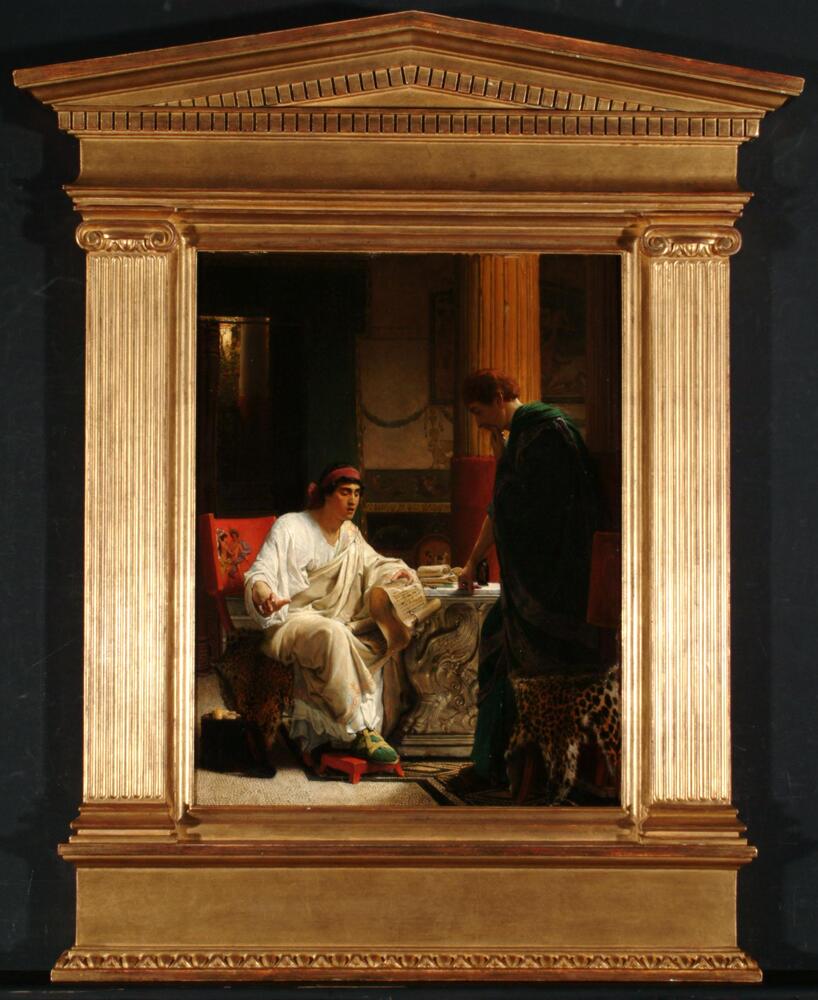Essay: Alma-Tadema
During the latter half of the nineteenth century, avant-garde movements radically rejected the conventional ideologies and practices of the past centuries.
Though several academic artists were affected by these changes, Northern-born painter Lawrence Alma-Tadema remained adamantly true to tradition and academic training. As Louise Lippincott articulates in her book Spring, even with the rise of Socialism and the avant-garde, Alma-Tadema continued to follow the traditional principles of academic art making.[1]
Born in Holland in 1836, Lawrence Alma-Tadema was a prolific classical painter and designer. During his lifetime, he was heralded as a master at his craft. His works were shown at the British Royal Academy, of which he was a member, and the Paris Salon. Although he was a native of the Netherlands, he is closely associated with the British artistic tradition and considered one of the great British painters.
Lawrence (born ‘Lourens’) Alma-Tadema was trained in Antwerp at the Royal Academy. He was eager to develop his own style after studying the works of the Old Masters. In 1870, Alma-Tadema moved to England, the country with which he is most closely linked. He became a member of the extremely prestigious Royal Academy of Arts in London. By the 1880’s, he had become a permanent fixture in the London art scene. He exhibited there regularly with other top painters of the day while also maintaining connections with other private patrons.
By the end of the nineteenth century, the beginnings of an avant-garde art movement had gained a kind of prestige none of the traditionalists had thought possible. As a result, the Royal Academy and its conventionalism fell out of favor. Alma-Tadema’s career was hardly tarnished, however, as he received the honor of knighthood in November of 1899 from Queen Victoria. After his death in 1912, he was buried at the prominent Saint Paul’s Cathedral.
Object Information:
In the nineteenth century, Neoclassicism was the predominant art movement. Alma Tadema’s work is definitively Neoclassical, and also incorporate some of the tropes of Romanticism. Overtly conservative, and rooted in the ideals of the Renaissance and classical Rome and Greece, it often employed subject matter that exalted civic virtue. Although Romanticism focused on more dramatic and emotional themes, and used a more personal, spontaneous style. It also turned to themes of history and politics.
This scene depicts the moment that the Roman emperor Vespasian discovers that his eldest son, Titus, has sacked the city of Jerusalem. This was a great victory for Vespasian and one of the high points of his reign. Alma-Tadema’s treatment of the subject is particularly entrancing. The intense contrast of shadow and light dramatizes a quiet moment. Although he has chosen a triumphant event, the painting is not celebratory. Instead, Alma-Tadema has selected a contemplative moment, which makes this work stand out among other academic works. His expressive mitigation of light and dark is more reflective of the Romantic flair for drama.
Technique: Oil on Panel
Although canvas was by far the most popular painting surface during his lifetime, Alma-Tadema chose to paint on wooden panel. Panel had not been in regular artistic use since the sixteenth century. Alma-Tadema created a connection to history not just through his subject matter but through the actual object itself.
This Vespasian panel and ornate frame would have reminded viewers of the highly decorated frames of the past, such as we see in UMMA’s Enthroned Madonna and Child with Saints and Angels by Jacopo del Casentino, circa 1325. Interest in panel work in the late-nineteenth century spiked particularly in the Northern European countries, where earlier artists like Rembrandt chose the medium in an effort to created more detailed work.
Themes and Ideas for Teaching
- What about this painting makes us consider it Neoclassical? What might characterize it as Romantic? If Neoclassicism is about honor and Romanticism about drama, how do you think Alma-Tadema mitigated these two concepts in this single frame? Did he do a good job? Think about how history plays a role in the characterization of both Neoclassicism and Romanticism.
- Alma-Tadema was a traditionalist working during a time of innovation. Given that many artists were looking toward a modern, avant-garde art, do you think that Alma-Tadema might have been breaking with accepted traditions (even new ones) in his own way? How?
Sources
Barrow, R. J. Lawrence Alma-Tadema. New York, New York: Phaidon Press, 2001.
Inglis, Alison. “Sir Lawrence [Laurens, Lorenz, Lourens] Alma-Tadema [Alma Tadema]” Grove Art Online. Oxford University Press, 07 February 2008, http://www.groveart.com.
Lippincott, Louise. Lawrence Alma Tadema: Spring. Malibu, California: J. Paul Getty Museum, 1990.
Maas, Jeremy. “Gambart, Ernest” Grove Art Online. Oxford University Press, 04 March 2008, http://www.groveart.com.
Stokstad, Marilyn. Art History, 2nd ed. New York, New York: Harry N. Abrams, Incorporated, 2002.
Wikipedia Contributors. “Panel painting,” Wikipedia, The Free Encyclopedia. http://en.wikipedia.org/wiki/Panel_painting, accessed 02 May 2008.
Wikipedia Contributors. “Vespasian,” Wikipedia, The Free Encyclopedia. http://en.wikipedia.org/w/index.php?title=Vespasian&oldid-191563113, accessed 18 February 2008.
Jane Braun (2008)
[1] Louise Lippincott, Lawrence Alma-Tadema: Spring (Malibu, CA: J. Paul Getty Museum, 1990).
Created For
K-12 EducatorK-12 Student
Museum Visitor
UMMA Docent
UMMA Staff
University Faculty
University Student
Rate this Resource
AVG: 0 | Ratings: 0
& Author Notes
Creative Commons by-nc-saLast Updated
April 9, 2018 2:42 p.m.Report
Reporting Policy

